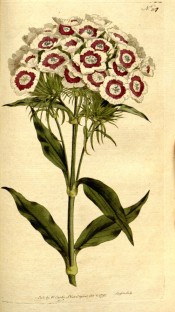Dianthus barbatus L.
Bushy, short-lived perennial, usually grown as a biennial, the clusters of small, sometimes double, often sweet-smelling flowers appearing in late spring and early summer. There are many garden cultivars in a wide range of colours. To 70cm. [RHSE, Hortus].
Horticultural & Botanical History
‘Sweet-William is a very old inhabitant of the gardens, and was very much esteemed in the time of Gerarde for its beauty, to deck up the bosoms of the beautiful, and garlands and crowns for pleasure. The varieties are endless.’ [Don]. Curtis’s Botanical Magazine figures a variety esteemed at the time, ‘Painted Lady’, a crimson-purple with a white eye and the petals fringed with white, indistinguishable from many modern varieties. ‘Beautiful as are the numerous varieties of this species of Dianthus, Florists have not deemed it worthy of that peculiar attention which they have bestowed on its more favoured relatives the Pink and Carnation, and hence it probably has not arrived at that degree of improvement of which it is capable.’ [BM t.207/1792]. The Sweet William had a brief vogue as a florists’ flower but never achieved the popularity of its close cousins, carnation, picotee and pink. ‘At the time Dodonaeus wrote (1552) this plant was cultivated in the Netherlands, from whence it was probably introduced to this country, where it certainly is one of the oldest inhabitants of our gardens. [BM t.207/1792].
History at Camden Park
Listed in the 1845, 1850 and 1857 catalogues [H.89/1845], although such a popular garden plant is likely to have been grown earlier. Macarthur obtained Sweet William seed, comprising 20 varieties, together with seed of a double scarlet variety, from James Carter, Florist and Seedsman of High Holborn, with whom an order was placed on 8th of April 1846. [MP A2933-1, p.128].
Notes
Published Apr 12, 2009 - 03:19 PM | Last updated Jul 16, 2010 - 02:16 PM
| Family | Caryophyllaceae |
|---|---|
| Category | |
| Region of origin | Southern Europe to India |
| Synonyms | |
| Common Name | Sweet William |
| Name in the Camden Park Record | Dianthus barbatus |
| Confidence level | high |


